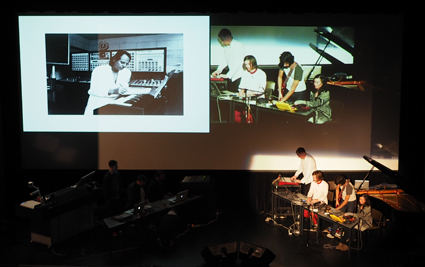Stockhausen, May 68: intuition & liberation
Chris Reid: Karlheinz Stockhausen—Electronic Music

Karlheinz Stockhausen—Electronic Music
photo Sebastian Tomczak
Karlheinz Stockhausen—Electronic Music
The work of legendary composer Karlheinz Stockhausen (1928-2007) is an essential introduction for any student to the field of electronic music that he did so much to establish, and though Stockhausen himself appeared in Adelaide in 1970, his work is rarely heard here.
This concert by 47 Bachelor of Music (Sonic Arts) students of the University of Adelaide was most welcome, focusing on works written by Stockhausen in the period 6-13 May 1968, when his disintegrating marriage caused emotional turmoil. That week coincided with the rioting and general strikes in Paris and elsewhere in Europe that proved a turning point in European politics, and images of these events were shown throughout the concert. Stockhausen’s consoling immersion during that week in the philosophy of Indian mystic Sri Aurobindo precipitated a major shift in his musical direction.
The 14 compositions comprising Aus den sieben Tagen (From the Seven Days) established Stockhausen’s concept of intuitive music, each piece taking the form of a short instructive text, rather than a score, outlining ideas to which the performers are to respond intuitively. For example, the instructions for Verbindung (Connection) are: “Play a vibration in the rhythm of your body/ Play a vibration in the rhythm of your heart/ Play a vibration in the rhythm of your breathing/ Play a vibration in the rhythm of your thinking/ Play a vibration in the rhythm of your intuition/ Play a vibration in the rhythm of enlightenment/ Play a vibration in the rhythm of the universe/ Mix these vibrations freely/ Leave enough silence between them.” For this concert, the selection from the 14 pieces included Unbegrenzt (Unlimited) 1–5, Setz die Segel zur Sonne (Set Sail for the Sun) 1 and 2, Treffpunkt (Meeting Point), Verbindung (Connection) and Ankunft (Arrival). The instructions for them suggest the meditative, internally focused process required of the performer to channel the cosmic awareness in which Stockhausen was interested.
The students work in groups of four or five with an array of synthesisers, the ubiquitous laptops, a tape-loop, the occasional electric guitar and even voice—the instrumentation is not prescribed and they could have chosen acoustic instruments. Such a script is almost a blank canvas for the performer, and can be seen both as a form of spiritual liberation and the ritual abandonment of conventional composition. The ensemble members presumably work independently of each other to respond to their own inner landscape, but as they also respond to each other’s motives, group consciousness and direction seem to emerge, resulting in an absorbing and musical blend of sounds. That the performers can make such interesting music with so little direction indicates the depth of their creativity and their technical, improvisational and ensemble skills.
Iran Sanadzadeh’s contribution was particularly notable as the image on her laptop screen was projected adjacent to the archival film of the 1968 Paris riots. The audience could see her typing text in both English and Arabic during her ensemble’s rendition of Unbegrenzt, highlighting the concept of textual meaning and its translation sonically, visually and culturally. Also briefly screened during the evening were critiques of Stockhausen, such as those by radical composers Henry Flynt and Cornelius Cardew, who complained that he served the establishment. Stockhausen was indeed a controversial figure, and this concert locates him in the revolutionary cultural milieu of his earlier years.
Karlheinz Stockhausen—Electronic Music, University of Adelaide students directed by Stephen Whittington; Scott Theatre, University of Adelaide, 12 June
RealTime issue #122 Aug-Sept 2014 pg. 50






